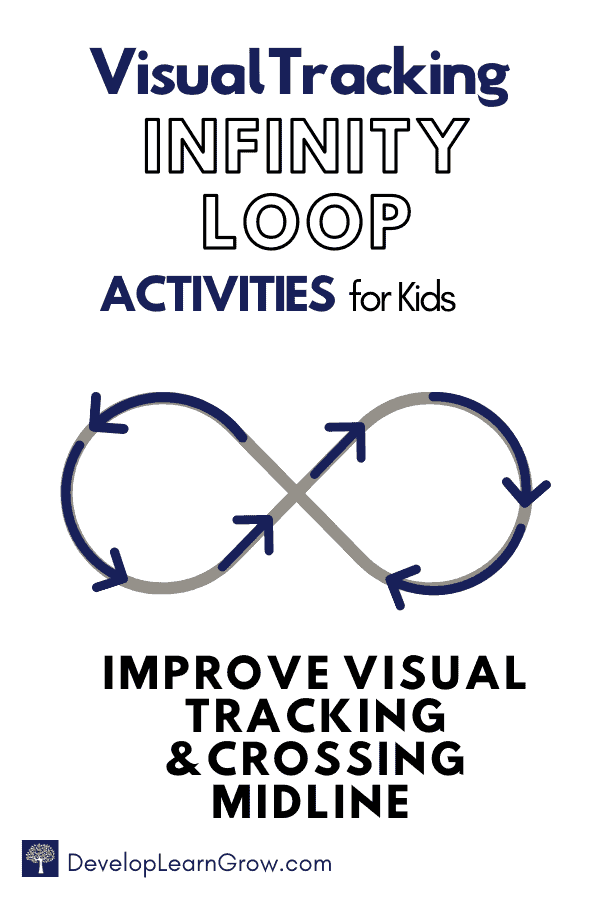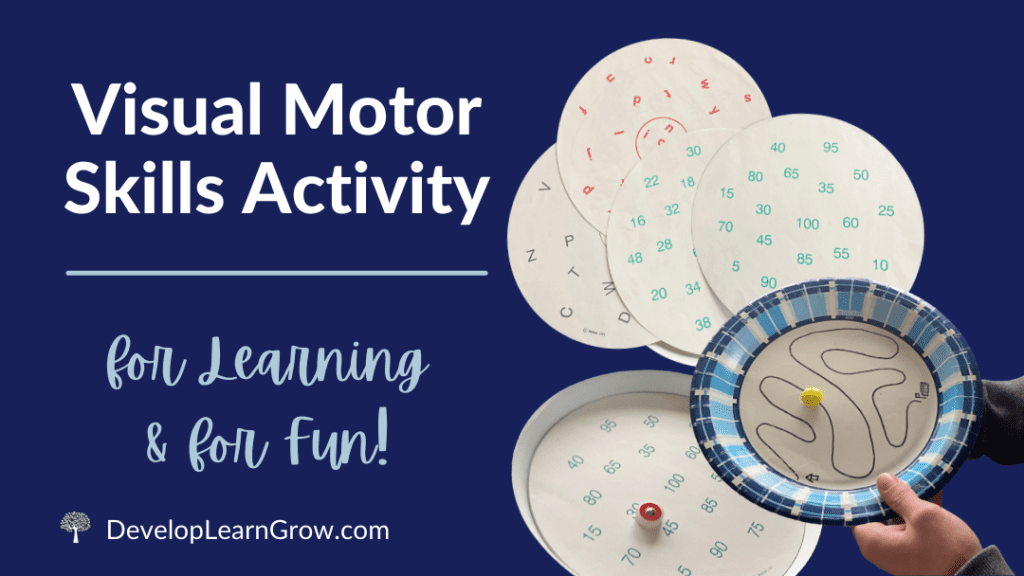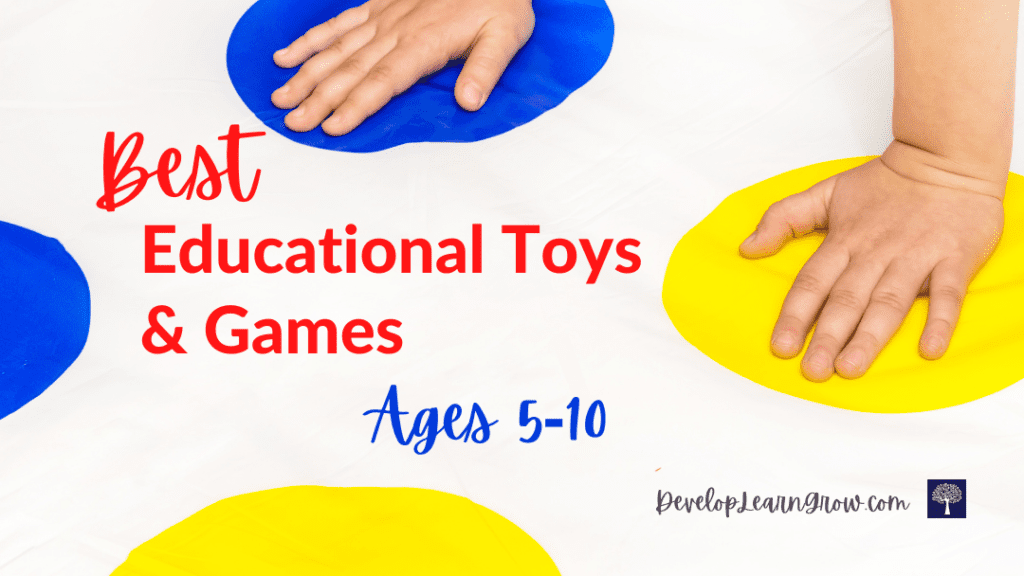Visual tracking activities are important for school skills. Using the infinity loop with learning activities is an added bonus for strengthening the eye muscles… it helps them to smoothly cross midline.
Kids use their eyes ALL day long for school tasks! The eyes often have to work hard for learning, even if the muscles aren’t ready and mature enough.
Children look around the room, at their papers and books, up at the teacher and/or board, sometimes at screens, and so on. A child’s eye muscles need to move smoothly and efficiently without getting tired.
Exercising the eyes and moving them in the right directions is important.
What is Visual Tracking and Why Use the Infinity Loop for Visual Tracking Activities?
Visual tracking involves following a moving object smoothly using only the eyes. The eyes should move independently from the head (the head and body should stay still as the eyes follow an object.)
As an occupational therapist, there are several visual tracking activities that I love to use to help kids. The infinity loop is one of my favorites!
It’s similar to the Lazy 8 from Brain Gym®. A program that has numerous research studies showing its effectiveness in improving kids’ test scores. Brain Gym® is further discussed on this website, Integrated Learning Strategies Learning Corner.
The exercise series listed in the Best Brain Break free handout on this blog include the some Brain Gym® exercises as well as the infinity loop exercise. It’s a super effective exercise that involves crossing midline!

Crossing midline on the upper body typically means a child’s ability to reach their hand across the imaginary middle line of their body (without turning at the waist.)
When a child crosses midline, it helps the two sides of the brain communicate.
In addition to reaching the hands (or feet) across the body’s midline, the eyes also need to smoothly cross midline.
I’ve often seen kids eyes “jump” while they are tracking a moving object across midline. They lose focus when their eyes attempt to cross the middle of their body. This causes problems when reading!
The infinity loop is a great way to work on this!
How to Use the Infinity Loop for Visual Tracking Activities
There are many ways to use the infinity loop for visual tracking activities. If I’m going to have a student use it as an exercise – I often incorporate learning tasks into the activity!
I have students stand in front of a large infinity loop either on poster board taped to a wall or at a chalkboard or dry erase board.
They stand with their body still and hold their arm out straight to move around the loop.
Or, the infinity loop can be used as a visual-motor integration activity for repeated tracing on a chalkboard. I will sometimes have them use several different colors of chalk for 3-4 “laps” around the loop.
It’s important that kids keep their bodies still when moving their arm to this motion. The hips and trunk should stay squared up to the paper and the arm should stay straight. Arm movements should come from the shoulder.
It’s best to use a large motion… as far as the arm can stretch in either direction!
The arm movement should be smooth the entire way around the loop for several consecutive “laps” using this motion:
Start at the center – move up and around to the left –> continuing around & back to the center –> continuing up to the right –> back around to the center –> continuing up to the left and around to the center –> up to the right and around to the center…

If it helps to get into more of a rhythm, you can say “up to the left, back to the center, up to the right, back to the center” and repeat as needed until the movement is smooth for several cycles. For kiddos who move faster, try “up-around, up-around.”
If the cue “up” is given when they reach the center, it can prevent them from reversing the direction and dropping downward when in the middle of the loop.
Examples of Learning Concepts to Use with the Infinity Loop
Children can hold an index card with text or a flashcard out in front of them and move it around the loop, following the correct direction.
For example, if practicing sight words, they hold the card with the sight word on it. With their hand stretched out in front of them, they smoothly move their arm around the infinity loop. They can say the sight word as it passes midline (or whenever is easiest for that child!)
Or, a child can hold a math card and keep their eyes on the numbers as they are following the motion. They can say the math problem “3×2=6” as they move their arm around the infinity loop.
On the reverse side of the math card, the card can say “3×2=?” The child repeats the math problem and answers it as he / she moves the card around.
The following are example learning concepts that can be used with the infinity loop.
- Learn colors
- Name shapes
- Practice identifying letters
- Say numbers
- Practice letter sounds
- Identify punctuation marks
- Count dots or objects on cards
- Recite letters of first or last name
- Learn sight words
- Read short sentences
- Count by 2’s, 5’s or 10’s
- Recite fact families
- Spell words
- Practice addition and subtraction
- Learn vocab words and definitions
- Memorize facts from a social studies lesson
- Practice science terms and definitions
- Recite multiplication problems
- Memorize geography facts
- Identify parts of a sentence
The list could continue! Hopefully this gives you an idea of learning concepts that can be used with the infinity loop!
My favorite part of this activity is that students are not just relaxing while using flashcards for learning.
They are standing, strengthening postural and shoulder muscles, using arm movements that activate both sides of the brain, and most importantly… the eyes are tracking a moving object while crossing midline!
The more parts of the body we use, the more parts of the brain we stimulate!!
Additional Tips for Visual Tracking Activities Using the Infinity Loop
When children are first learning the motion, it helps to place a large loop on a wall with no visual distractions.
Examples might be a plain wall without any wall hangings or patterns. Or the back of a plain solid door.
Use the verbal cues from above, simplify (“up-around”) when possible.
If a child is having trouble keeping their body still, have them place their opposite hand on the opposite hip to stabilize the trunk. If following the infinity loop motion with the right hand, place the left hand on the right hip. On the contrary, if using the left hand, place the right hand on the left hip.
When possible, have children pair up and move the cards around the loop for each other!
For more information like this, check out the following posts containing more visual motor activities and visual tracking activities and other ideas for brain breaks…
Check Out These Posts for More Visual Motor Integration and Visual Tracking Activities:
Click Below for More Brain Break Activities Posts:
FREE Printable: 25 Brain Breaks for Kids: Improve Focus and Attention (using the proprioceptive system.)
30 Great Movement Activities (for small or large spaces – no equipment needed!)
18 Quick Midline Crossing Activities for Academic Tasks
Want More of a Challenge for Your Students? Here’s an 8-Week Classroom Exercise Program:
Use these specific occupational therapy exercises to improve:
Attention… focus… core stability… crossing midline… sensory processing… visual development… & more… Click for more info!







0 Comments